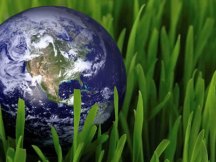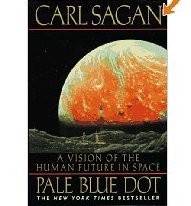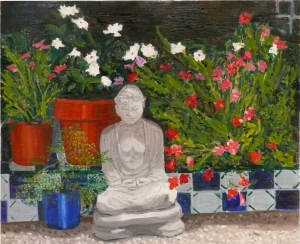 GREEN is a multipurpose color, and lately it is the universal icon for a healthy Earth.
GREEN is a multipurpose color, and lately it is the universal icon for a healthy Earth.
The concern we raise in this post is whether we have the collective will and conscience to change our destructive consumerist habits. Maybe we are not really capable of rising to the challenge of healing our planet.
Save the Earth strategies don’t really address the driver, our economic materialism — when the economy is bad, we must buy more stuff! Just be sure to recycle.
Professions of concern that skirt issues like planned obsolescence, are disingenuous as plastic grass. But no worries. Today we’re all about red ribbons and promises of rose gardens — yep, it’s Valentine’s Day! ♥
Foolishly idealistic it might be, but we ask: shouldn’t the world’s human lovers be paying equal homage to Mother Nature — she who designed and grew those Valentine roses? And not only on these special occasions, but every day?
Many diverse cultures makeup Earth’s great family, and many are suffering. Should not the upscale élite, those few well fed and living comfortable lives — the consumers of flowers and chocolates — assist their less fortunate brothers and sisters? Or, in such difficult times as these, should the prudent watchword be: “every person for himself?”

The Hero’s Journey
Even in the worst of times, a compassionate hero-soul knows when to renounce personal preferences, and figures out how to help secure the well-being and happiness of everyone sharing the same planetary space. ♥
Ideally, he or she would nurture compassion and loving kindness regardless of race and creed. But which attributes do we consciously cultivate most often in our hearts, in everyday life?
According to a hopeful 11-year-old vocalist Billy Gilman, there’s a “hero in everybody’s heart”:
Surely if we fail to recognize universal unity of humanity and nature — a living, conscious relationship, as did the Ancients — and continue our isolated state of mind, the Sacred will be lost.
Our heart’s voice, and that of our Planet, in that case, will continue to elude us.
 The human heart is tiny by comparison with a planet. It’s also a pump composed of muscle which moves blood through the body, beating about 72 times a minute. It pumps about 5 liters per ventricle, or about 10 liters total a minute.
The human heart is tiny by comparison with a planet. It’s also a pump composed of muscle which moves blood through the body, beating about 72 times a minute. It pumps about 5 liters per ventricle, or about 10 liters total a minute.
No slacker the heart. Every time it contracts it does so with all its force.
The entire cycle lasts about eight-tenths of a second with the heart resting about four-tenths of a second. That’s a lot of work for a small organ. ♥
Will Science be our Savior?
Perhaps soon, new generations of scientists will listen and act on their heart-felt inspirations, as did Devin Weinberg, Jessie Brandwein, and Alex Venarchick. (Click here, or on the photo above for their story.)
“But modern science,” noted H. P. Blavatsky, about the 19th Century establishment, “believes not in the ‘soul of things.'”
“…the essence of these material manifestations — the ‘things in themselves,’ which, as modern science confesses, entirely elude the instruments of the laboratory, and which even the mind cannot grasp.”
 We continue to misread, and abuse, this small blue dot we call home. Yet, one scientist, Carl Sagan, gained and shared a faraway intuitive flash— a vision that all our minds and hearts, can easily grasp.
We continue to misread, and abuse, this small blue dot we call home. Yet, one scientist, Carl Sagan, gained and shared a faraway intuitive flash— a vision that all our minds and hearts, can easily grasp.
The Pale Blue Dot
♥
The Pale Blue Dot is a photograph of planet Earth taken in 1990 by Voyager 1, from a record distance, showing it against the vastness of space.
By request of Carl Sagan, NASA commanded the Voyager 1 spacecraft — having completed its primary mission and now leaving the solar system — to turn its camera around and take a photograph of Earth.
 It was subsequently used by Sagan as the title of his 1994 book of the same name. In 2001, it was selected by Space.com as one of the top ten space science photos. ♥
It was subsequently used by Sagan as the title of his 1994 book of the same name. In 2001, it was selected by Space.com as one of the top ten space science photos. ♥
“Help Nature and work on with her — and Nature will regard thee as one of her creators and make obeisance.”
Commercial motives cynically betray our better planetary spirit. The term “organic,” for example, has battled since the seventies with its own demons. Many “natural” and “organic” labels today are still deceptive, and often products contain harmful added ingredients.
A spiritual reminder from Albert Schweitzer plainly challenge these behaviors:
“Until he extends the circle of his compassion to all living things, man will not himself find peace.”
 Upon such beliefs, our health, happiness and lasting prosperity depend. Human beings are no longer guided directly by the all-wise spiritual parents of our planetary infancy, and according to Theosophy, we are nearly grown-up, self-conscious thinkers and choosers.
Upon such beliefs, our health, happiness and lasting prosperity depend. Human beings are no longer guided directly by the all-wise spiritual parents of our planetary infancy, and according to Theosophy, we are nearly grown-up, self-conscious thinkers and choosers.
What will we think about? Which direction will we choose at this crossroad?
What Would it Look Like?
Part 1
We have fought a losing battle against our core spiritual dharma for too long.
“Behold how like the moon, reflected in the tranquil waves, [spiritual wisdom] is reflected by the small and by the great, is mirrored in the tiniest atoms — yet fails to reach the heart of all.
♥
“Alas, that so few men should profit by the gift, the priceless boon of learning truth, the right perception of existing things …”
– The Voice of the Silence
 Ignorance, greed and soul-less egoism have periodically visited their karma on our civilizations — famines and dust bowls out of fertile lands, strange new pestilences and diseases, an expanding catalog of endangered species, a choking atmosphere, and an impending climate doomsday.
Ignorance, greed and soul-less egoism have periodically visited their karma on our civilizations — famines and dust bowls out of fertile lands, strange new pestilences and diseases, an expanding catalog of endangered species, a choking atmosphere, and an impending climate doomsday.
What Would it Look Like?
(Part 2 – Conclusion)
More Voices
♥
Internationally influential economic thinker E. F. Schumacher, best known for his critique of Western economies, and his proposals for human-scale, decentralized and appropriate technologies, gave us fair warning back in the 1970’s with a little book:
Small Is Beautiful: Economics as if People Mattered
 Schumacher’s legacy is alive today at The E. F. Schumacher Society. Schumacher’s writings are still an imperative read in today’s troubled society. In a representative example of his predictive philosophy, he wrote that a modern economist is:
Schumacher’s legacy is alive today at The E. F. Schumacher Society. Schumacher’s writings are still an imperative read in today’s troubled society. In a representative example of his predictive philosophy, he wrote that a modern economist is:
“… used to measuring the ‘standard of living’ by the amount of annual consumption, assuming all the time that a man who consumes more is ‘better off’ than a man who consumes less.

“A Buddhist economist would consider this approach excessively irrational,” Schumacher wrote:
“… since consumption is merely a means to human well-being, the aim should be to obtain the maximum of well-being with the minimum of consumption.”
Unless we come to realize that Nature and Man are One Being, that both are rich with hidden potentials of spirit and consciousness, then shades of gray will be our future’s only color.
MANAS and Henry Geiger
 “MANAS is a journal of independent inquiry, concerned with the study of the principles that move world society on its present course,” declared the MANAS publication statement, “and with the search for contrasting principles which may be capable of supporting intelligent idealism under the conditions of the twentieth century.”
“MANAS is a journal of independent inquiry, concerned with the study of the principles that move world society on its present course,” declared the MANAS publication statement, “and with the search for contrasting principles which may be capable of supporting intelligent idealism under the conditions of the twentieth century.”
___________________________________________________________
“MANAS was not a business affair for Henry Geiger but an affair of the heart. The saving and sharing of MANAS with new readers for a new century has also been an affair of the heart.” ♥
Susan Witt
Executive Director
E. F. Schumacher Society
____________________________________________________________
Prominent among the writings featured by Theosophist Extraordinaire, Henry Geiger, where those of E. F. Schumacher — whose later influential essay Buddhist Economics was first published in MANAS.
♥
The efforts by the government of Bhutan are often considered an expression of Buddhist economics: for example, alongside traditional economic indicators, Bhutan uses ‘Gross national happiness’ to measure quality of life and non-economic well-being.
(See the Post: Buddha’s Big Fish)
 MANAS’ “pantheon of heroes and heroines,” writes Richard Grossman, were “Plato, Gautama Buddha, Lao Tse, Gandhi, Tom Paine, Emerson, Pico della Mirandola, Simone Weil, Jose Ortega y Gassett, Abraham Maslow, Hannah Arent, Thoreau, and a host of others.”
MANAS’ “pantheon of heroes and heroines,” writes Richard Grossman, were “Plato, Gautama Buddha, Lao Tse, Gandhi, Tom Paine, Emerson, Pico della Mirandola, Simone Weil, Jose Ortega y Gassett, Abraham Maslow, Hannah Arent, Thoreau, and a host of others.”
No minor voices were they.
____________________________________________________________
♥ Enjoy two more reviews on MANAS and Henry Geiger, by Scott Lahti at:
AMAZON
&
ALEXANDRIA
____________________________________________________________
“A man is rich in proportion to the number of things he can afford to let alone.” -Thoreau
“With One Voice”
♥
Matthew Flickstein’s vision is the force behind the documentary With One Voice. He began writing and producing the film in December of 2006.
“One moment, outside of time, and my life changed forever,” Flickstein reveals. “No apparent cause for the experience. There was just a direct realization that I was not my body or my mind. Who I truly was had never been born and would never die.
“Since that time, thirty-three years ago,” he says, “this intuitive understanding has never left my consciousness.”
“Life as I had known it fell apart,” Flickstein confesses. “I could not eat, I cried continuously, and my body shook for days on end. I thought I was going to die.”
“Every unskillful action I had committed in my life came to the fore of my mind along with the compulsion to make amends.”
“What I discovered,” he writes, “was that at the core of all religions and spiritual paths, there is only one unifying truth: one Ultimate Reality that unites us all. In 2006, I awoke with the idea of creating a documentary to bring this life-affirming message of hope to the world.” ♥
“After two and one-half years of interviewing renowned mystics from the world’s great sacred traditions, this vision has come to fruition with the production of With One Voice.”
 Talking Trash with Annie Leonard
Talking Trash with Annie Leonard
“Annie has spent nearly half of her life traveling to more than 30 countries to witness the environmental impact of casual consumerism and the travails of those who make what we consume,” writes Bryony Schwan for Time.com, “and she has spent countless hours working to right these injustices. ♥
“Which is why when Leonard talks trash, people cannot help but listen.”
 We are a consumer society with a throwaway mindset. In her video, called “The Story of Stuff,” Annie reveals how it happened.
We are a consumer society with a throwaway mindset. In her video, called “The Story of Stuff,” Annie reveals how it happened.
“From its extraction through sale, use and disposal, all the stuff in our lives affects communities at home and abroad, yet most of this is hidden from view.”
The Story of Stuff is a 20-minute, fast-paced, fact-filled look at the underside of our production and consumption patterns.
“…there exists in Nature a triple evolutionary scheme…or rather three separate schemes of evolution, which in our system are inextricably interwoven and interblended at every point. These are the Monadic (or spiritual), the intellectual, and the physical evolutions.”
– H. P. Blavatsky, The Secret Doctrine I:181
Barry Manilow – One Voice
♥
♥
“Time to Say Goodbye”
Andrea Bocelli and Sarah Brightman
Nature’s Voice
“Behold, the mellow light that floods the Eastern sky. In signs of praise both heaven and earth unite. And from the four-fold manifested Powers a chant of love ariseth, both from the flaming Fire and flowing Water, and from sweet-smelling Earth and rushing Wind. Hark! from the deep unfathomable vortex … all Nature’s wordless voice in thousand tones ariseth to proclaim … ♥
“Peace to all beings.”











Scott,
Many thanks for the useful feedback. The links to your two reviews have been added to the post.
Warm wishes,
Odin
LikeLike
I was happy to see the references to MANAS and its editor, Henry Geiger. I hope you enjoy my post on MANAS, and my review of THE MANAS READER.
http://aleksandreia.wordpress.com/2008/11/20/free-the-resurgence-250-and-manas-he-might-be-and-could-be/
http://www.amazon.com/review/R27G9D7RSNOGXB
LikeLike